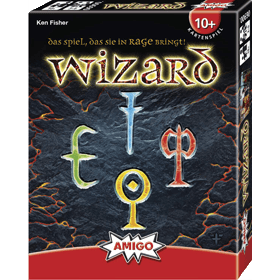Wizard
 Le Wizard est un jeu de plis qui utilise un jeu de 60 cartes composé du traditionnel jeu de 52 cartes (de 1 à 13 dans quatre couleurs) avec en plus quatre Wizards (Magiciens – cartes les plus fortes) et quatre Jesters (Bouffons – cartes les plus faibles).
Le Wizard est un jeu de plis qui utilise un jeu de 60 cartes composé du traditionnel jeu de 52 cartes (de 1 à 13 dans quatre couleurs) avec en plus quatre Wizards (Magiciens – cartes les plus fortes) et quatre Jesters (Bouffons – cartes les plus faibles).
Les joueurs s’affrontent sur un nombre de manches déterminé en fonction du nombre de joueurs, et celui qui termine avec le score le plus élevé gagne. À chaque manche, les joueurs reçoivent une main de cartes – une carte à la première manche, deux cartes à la deuxième, trois à la troisième, etc. – puis l’atout est déterminé en retournant la carte du haut de la pile des cartes non distribuées ; si une carte de couleur est révélée, cette couleur correspond à l’atout, alors que si la carte présentée est un Jester, il est retourné et il n’y a pas d’atout pour cette manche. Si la carte retournée est un Wizard, celui qui a distribué choisit l’une des 4 couleurs comme atout. Il ne peut pas choisir « sans atout ». Pour la dernière manche toutes les cartes sont distribuées, il n'y a donc pas d’atout. Les joueurs prédisent ensuite le nombre de plis qu'ils s’attendent à gagner durant la manche.
Nombre de joueurs: 3 - 6
Durée de la partie : 20 mn
Complexité : 3 / 5
Jouez à Wizard ou à 978 autres jeux en ligne.
Sans téléchargement, directement depuis votre navigateur.
Avec vos amis et des milliers de joueurs du monde entier.
Gratuitement.

Jouez à Wizard ou à 978 autres jeux en ligne.
Sans téléchargement, directement depuis votre navigateur.
Avec vos amis et des milliers de joueurs du monde entier.
Gratuitement.

Résumé des règles
Objective
The objective is to correctly predict the number of tricks you will take in each round in order to receive points. Highest score wins!
Gameplay
- Shuffle all 60 cards, include 13 dwarves, 13 elves, 13 giants, 13 humans, 4 wizards and 4 jesters.
- Deal a number of cards equal to the round number to each player. The next card turned up is trump.
- If the card is jester, there is no trump. If the card is wizard, the dealer chooses the trump. In the last round there is no trump.
- Each player, starting from the player to the left of the dealer, bids a number of tricks that they are going to take.
- The player to the left of the dealer starts the first trick and leads any card. If the card led is a wizard, it wins (the other players may play any suit). If it is a jester, the next card played determines the lead suit. If only jesters are played, the first jester wins.
- Players must follow suit if possible. If a player cannot follow, they play any other suit, including the trump suit. Wizards and jesters can be played at any time.
- A trick is won by the first wizard played. If there are no wizards, it is won by the highest trump. Else, it is won by the highest card of the lead suit. The winner of a trick leads the next trick.
Scoring
- If a player predicts correctly, they score 20 points, plus 10 points for each trick taken.
- If a player predicts wrongly, they lose 10 points for each over or under trick.
End of Game
- When all the cards are dealt out in a round, that round is the last.
- That means there are 20 rounds with three players, 15 rounds with four, 12 rounds with five and 10 rounds with 6.
- At the end of the game, the player with the highest score wins.
Variants
Bidding
- Hidden prediction: Predictions are revealed simultaneously before the round is played.
- Plus/minus 1: The total number of tricks predicted by the players may not equal the number of tricks available in any round.
- Secret prediction: Predictions are not revealed until the round ends.
Game Length
- 5 rounds: Only 5 rounds are played.
- Amigo tournament rules: 10 rounds are played with modified number of cards. With 3 players, start with 2 and add 2 each round. With 4 players, start with 1, add 2 until the 6th round, then add 1 each round. With 5 players, start with 2, add 2 in 2nd round and 1 in other rounds.
Foresight
In the first round, when each player only has one card, players do not look at their own cards. Each player holds their card up in front of their forehead so all other players can see the front of the card. After all players have seen the others’ cards, but not their own, predictions are made.


